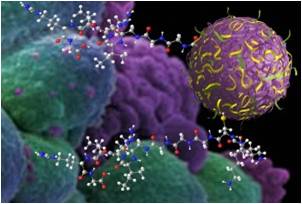Drug delivery technology has received considerable attention in the past few years in the field of biomedical nanotechnology. Drug delivery implies that the approaches, technologies, process and systems for transporting a pharmaceutical compound in the body as needed. Drug delivery system is related with the quality, quantity and duration of drug presence. It is also concerned with scientific site of pharmaceutical compounds within the body. That means proper drug delivery system must transport pharmaceutical compounds with proper quantity into the accurate sites of the body. Drug delivery is often approached via a drug's chemical formulation, but it may also involve medical devices or drug-device combination products.

Image retrieved from: http://trialx.com/curetalk/2012/10/17/nanotechnolo...
Silicon (Si) is a biomaterial, one of the most frequent elements in the earth’s crust. A range of methods can be applied for the fabrication of porous Si, such as chemical stain etching, chemical vapor etching, laser-induced etching, metal-assisted etching, spark processing and reactive ion (plasma) etching. Porous Silicon nanoparticles/nanopowder can be seen as one of the attractive materials for controlled drug delivery applications. Porous Silicon nanoparticles/nanopowder have been established as excellent candidates for medical applications as drug delivery devices, due to their excellent biocompatibility, biodegradability, and high surface area. Also there are some other several important properties of porous silicon nanoparticles/nanopowder such as controllable pore sizes and volumes, optical properties, usage as a template for organic and biopolymers.
It is possible to make some modifications on porous Si surfaces that can be used to control the amount, identity and in vivo release rate of drug payloads. Furthermore, there are some well-established methods of fabrication for possible users which can be customized to control the pore size, chemical modification of silicon surfaces and the characterization and pore morphology of silicon structures.
Porous Silicon nanoparticles/nanopowder can be used in not only drug delivery, but also microfluidics, microarray biosensors and high-resolution imaging techniques that can provide detailed images of cancerous cells and lesions, thus these nanoparticles/nanopowder are creating systems with incredible synergetic capabilities for therapeutic and diagnosis applications.
Comments
Post a Comment